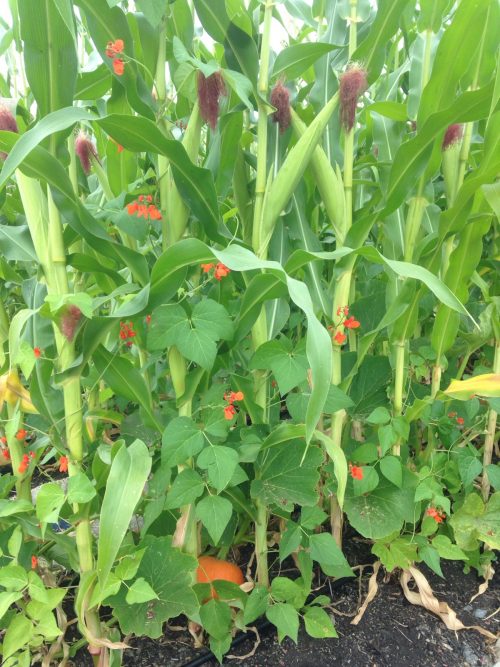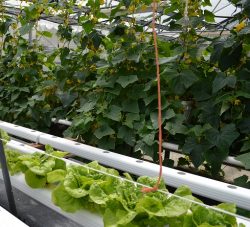How We Grow
 We grow all of our produce without the use of chemicals or synthetic inputs. We choose soil preparation and cultivation practices that maintain or improve the biological condition of the soil and minimize erosion. We encourage soil fertility through rotations, cover crops and the application of plant and animal materials.
We grow all of our produce without the use of chemicals or synthetic inputs. We choose soil preparation and cultivation practices that maintain or improve the biological condition of the soil and minimize erosion. We encourage soil fertility through rotations, cover crops and the application of plant and animal materials.
Crop Plan
Blueberries
We have over 50 blueberry bushes in the Learning Garden. Varieties include Bluecrop, Chandler, Patriot, Jersey, and Duke. These blueberries are covered with a green net so that we get the berries before the birds! We raise the nets in the spring allowing the bees to pollinate, and pull them down when the bushes start producing. Blueberries harvested are sold at Portlandia FarmStandia.
Orchard
The Learning Garden is host to an orchard consisting of 67 trees including apple, pawpaw, elderberry, mulberry, pluot, cherry, fig, peach, nectarine, persimmon, asian pear, and pear. The orchard provides pollination for our bees, harvest for the farm stand and cafeteria, and educational opportunities for our students.
Cane Fruits and Grapes
The cane fruit field is one of the more recently established features of the Garden. Planted in 2015, our cane fruits include raspberries, blackberries and marionberries. Grapes are also planted in this area. This part of the Garden is slated for moderate expansion in the near future. As with our other produce, fruits harvested are directed to Portlandia FarmStandia or the College’s Dining Services.
Hydroponics
 Hydroponics is a method of growing plants that does not require soil. Instead, the plant roots are supported in an inert medium, like rockwool, perlite, clay pellets, peat moss, or vermiculite. The roots touch a water-based nutrient solution that is pumped through the system, but still have plenty of access to oxygen.
Hydroponics is a method of growing plants that does not require soil. Instead, the plant roots are supported in an inert medium, like rockwool, perlite, clay pellets, peat moss, or vermiculite. The roots touch a water-based nutrient solution that is pumped through the system, but still have plenty of access to oxygen.
PCC Rock Creek’s hydroponics include a Nutrient Film Technique system and a Dutch Bucket system as the result of a collaborative project between the Garden, the Landscape Technology Propagation and Environmental Studies Introduction to Closed Systems classes. Maintained and harvested by the Learning Garden staff and volunteers, the produce grown via hydroponics is sold at Portlandia FarmStandia.
Hoop House
The Learning Garden has partnered with the Landscape Technology (LAT) program and maintains 12 raised beds in the LAT hoop house (also called a “high tunnel”) to extend the Garden’s growing season. One of the focal points in the hoophouse is the salad garden, with lettuces and greens grown to supply the PCC Dining Services with a consistent source of salad for the College cafeterias and catering jobs. The raised beds are constructed with wood from Juniper, a conifer invasive to Oregon. Juniper is considered a sustainable construction material because of it’s extremely durable nature and the process used to harvest it helps mitigate its invasive nature. Inside the hoop house, solar radiation warms the soil temperature in the raised beds throughout the winter. This allows the Garden to extend its growing season to support year-round production.
Irrigation
The Learning Garden uses drip irrigation as the primary mechanism for watering. Drip irrigation minimizes water consumption used in irrigation by reducing evaporation and is easier to maintain in a setting such as the Garden. We use an automated sprinkler system in the orchard.

